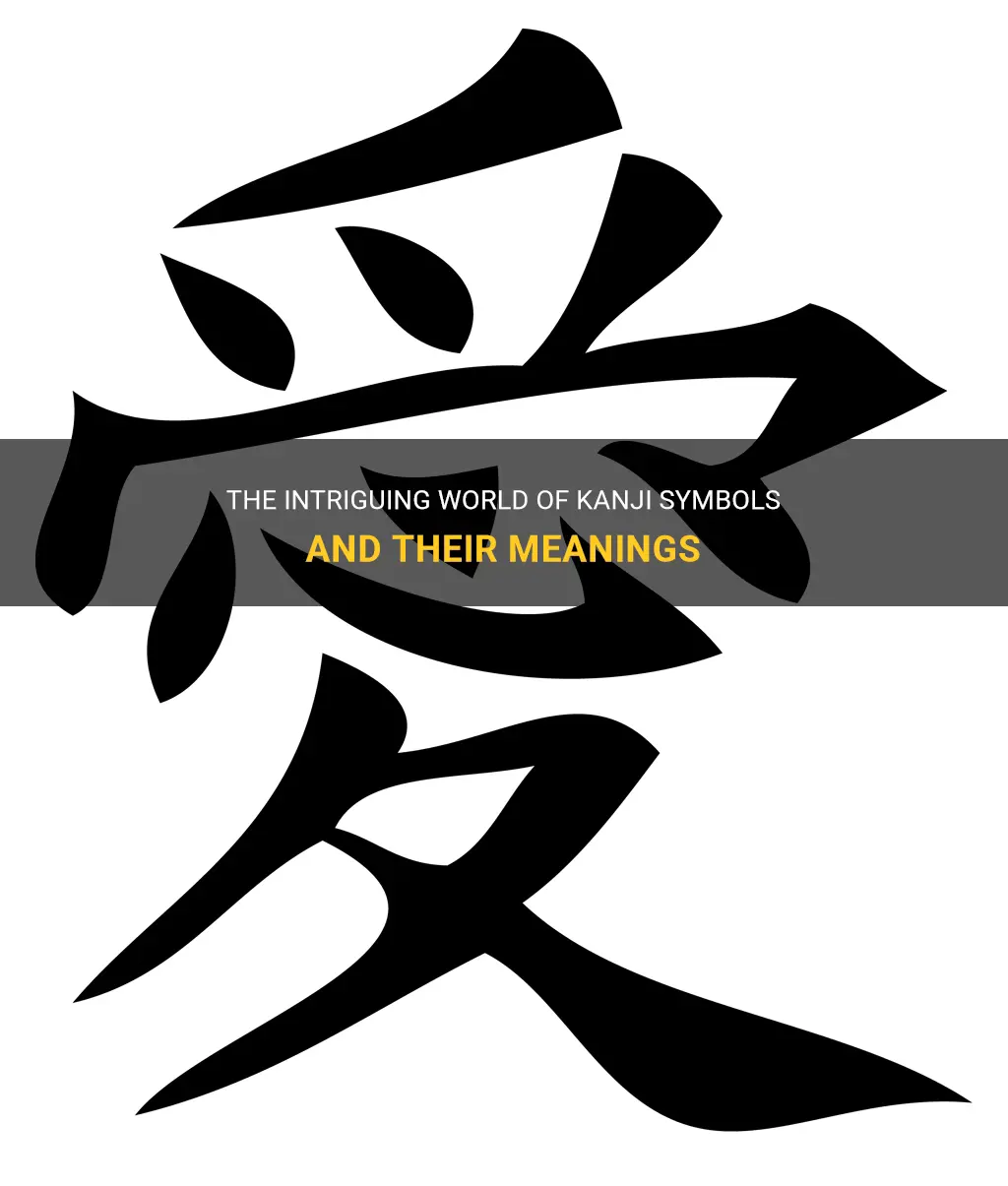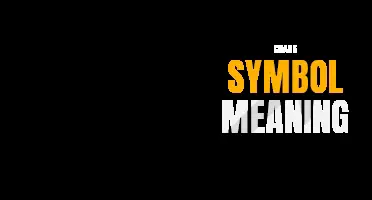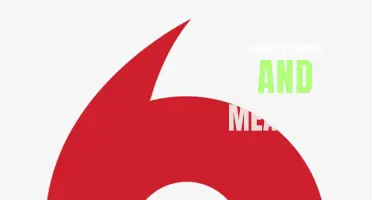
Kanji symbols are the building blocks of the Japanese language, each with their own unique meanings and interpretations. With a rich history dating back thousands of years, these intricate characters hold a fascinating story within their strokes. From simple concepts like love and friendship to complex ideas like perseverance and enlightenment, kanji symbols encapsulate the essence of Japanese culture and provide a captivating glimpse into the interconnected web of meanings that make up this ancient writing system. Whether you're a language enthusiast or simply curious about the world of kanji, prepare to embark on a captivating journey through the intricate world of symbols and meanings.
What You'll Learn

What is the significance of the symbols used in kanji?
Kanji is a system of writing used in the Japanese language. It originated in China and was introduced to Japan in the 5th century. Kanji characters are derived from ancient Chinese characters, with each character representing a word or concept. The symbols used in kanji have significant meaning and can convey various ideas and emotions.
One of the main aspects of kanji is the use of radicals. Radicals are the building blocks of kanji characters and give them their meaning. They are smaller elements within a character that can, in some cases, be seen as individual symbols themselves. For example, the radical for water (氵) is often found in characters related to water or liquids, such as 池 (pond) or 洗 (to wash). By understanding the meaning of radicals, it becomes easier to decipher the overall meaning of a kanji character.
Another important aspect of kanji is the use of strokes. Strokes are the individual lines used to form kanji characters. The number and order of strokes are significant and can affect the meaning of a character. For example, the kanji for "person" (人) consists of two strokes, whereas the kanji for "tree" (木) consists of four strokes. The stroke order is also important as it follows a specific pattern, which helps to maintain uniformity and legibility in overall writing.
Additionally, kanji characters often have multiple readings or pronunciations. These readings can sometimes vary depending on the context in which the kanji is used. There are two main types of readings: "on" readings, which are derived from the Chinese pronunciation, and "kun" readings, which are native Japanese readings. These readings are represented by different symbols called furigana, which are small hiragana or katakana characters placed above or beside the kanji.
The symbols used in kanji are not arbitrary but have evolved over centuries of use. Each symbol represents a specific word or concept, and the use of radicals, strokes, and readings further adds to the complexity and depth of meaning in kanji writing. Learning and understanding the symbols used in kanji is essential for anyone wishing to read and write in the Japanese language. It allows for a deeper understanding of the language and its cultural significance.
The Symbolic Meaning of Ivy: Uncovering Its Significance in Nature and Culture
You may want to see also

How many kanji symbols are there in total?
Kanji, the logographic characters borrowed from China, are an integral part of the Japanese writing system. These characters are used to represent words, concepts, and ideas in written Japanese. If you're learning Japanese, you may be curious to know just how many Kanji symbols there are in total.
The Kanji symbol set is vast, but the exact number can be debated. The Japanese government officially recognizes 2,136 Kanji symbols, known as the "Jinmeiyo Kanji." These characters are considered essential for everyday communication and are typically taught in schools.
However, this is just a fraction of the total number of Kanji symbols that exist. In fact, it is estimated that there are over 50,000 Kanji symbols in total. These additional Kanji symbols are known as "Joyo Kanji," which are taught up until high school and are considered more specialized or formal.
It's important to note that while there are thousands of Kanji symbols, the average Japanese person only needs to know around 3,000-4,000 to be considered literate. This is because many Kanji symbols have multiple readings and meanings, and the context often dictates which reading or meaning is intended.
Learning Kanji can be a daunting task, but it is an essential part of becoming proficient in reading and writing Japanese. Many Japanese language learners use textbooks, flashcards, and online resources to memorize and practice Kanji. It is recommended to focus on learning the most common Kanji symbols first and gradually expand your knowledge as you become more comfortable.
Overall, while there may be over 50,000 Kanji symbols in total, the average Japanese person only needs to know a fraction of that number to be considered literate. So don't be discouraged by the sheer number of Kanji symbols – with dedication and practice, you too can become proficient in this fascinating aspect of the Japanese language.
Decoding the Symbols on the BMW E90 Fuse Box: What Do They Mean?
You may want to see also

How do the meanings of kanji symbols differ from their pronunciation?
Kanji symbols are an integral part of the Japanese writing system. They are Chinese characters that were adopted and adapted to form the written component of the Japanese language. Each kanji symbol has a particular meaning and can also be pronounced in different ways, which may differ from its original Chinese pronunciation. This difference between the meaning and pronunciation of kanji symbols is a unique characteristic of the Japanese language.
The meaning of a kanji symbol is derived from its original Chinese character. Each symbol represents a concept or an idea and can often be broken down into smaller components that contribute to its overall meaning. For example, the kanji symbol for "tree" consists of two parts: one part represents "wood," while the other part represents "stand." When these two parts are combined, they create the symbol for "tree," which represents the concept of a standing wooden plant.
On the other hand, the pronunciation of a kanji symbol is not directly related to its meaning. Instead, each symbol can be pronounced in different ways, depending on its context and the other characters that accompany it. This multiple pronunciations phenomenon is known as "on-yomi" and "kun-yomi." On-yomi refers to the Chinese-based readings of kanji symbols, while kun-yomi refers to the native Japanese readings.
The pronunciation of a kanji symbol is influenced by the way the character was originally pronounced in Chinese, as well as its historical usage and evolution in the Japanese language. For example, the kanji symbol for "tree" can be pronounced as "ki" (on-yomi) or "ki" (kun-yomi), depending on the word or phrase in which it is used. Similarly, the kanji symbol for "person" can be pronounced as "jin" (on-yomi) or "hito" (kun-yomi).
The difference between the meaning and pronunciation of kanji symbols adds complexity to the Japanese language. It requires learners to not only memorize the meanings of individual kanji symbols but also understand their various pronunciations in different contexts. This aspect of the language can be challenging for non-native speakers, as it requires a deeper understanding of Japanese vocabulary and grammar.
However, it is important to note that the meaning and pronunciation of kanji symbols are not completely arbitrary. There are patterns and rules that can help learners predict the pronunciation of a kanji symbol based on its composition, historical usage, and context. For example, certain combinations of kanji symbols tend to have specific pronunciations, known as "jukujikun." These patterns can be helpful in navigating the complexities of Japanese kanji and improving overall language proficiency.
In conclusion, the meanings of kanji symbols differ from their pronunciation in the Japanese language. While the meaning of a kanji symbol is derived from its original Chinese character and represents an idea or concept, its pronunciation can vary depending on its context and the other characters it is used with. This difference adds complexity to the Japanese language and requires learners to have a deeper understanding of vocabulary and grammar. However, there are patterns and rules that can assist in predicting the pronunciation of kanji symbols, aiding in language acquisition and proficiency.
The Meaning Behind Bring Me The Horizon's Symbol: Decoding the Band's Iconic Emblem
You may want to see also

Can the same kanji symbol have multiple meanings?
Kanji is a system of writing that originated in China and is widely used in Japan. Each kanji symbol is a pictographic representation of a concept or an object. While most kanji symbols have a specific meaning, there are many instances where a single kanji symbol can have multiple meanings.
The underlying reason behind this is the evolution of the Japanese language and its incorporation of Chinese characters. Over time, the way words were pronounced in Japanese changed, but the written characters remained the same. As a result, a single kanji symbol could come to represent multiple different words with different meanings, depending on the context.
For example, let's take the kanji symbol "人" which means "person". This symbol can also be used to represent other words such as "human", "people", "individual", or "someone". The specific meaning of the symbol will depend on the context in which it is used. For instance, if the symbol appears in a word like "人々" (hitobito), it means "people". But if it appears in a word like "人格" (jinkaku), it means "personality".
Similarly, the kanji symbol "山" represents the concept of "mountain". However, it can also be used to represent the word "hill" or "small mountain" in certain contexts. The word "山脈" (sanmyaku), for example, means "mountain range". But if the symbol appears in a word like "山道" (yamamichi), it means "mountain path".
It is important to note that the meanings of kanji symbols can change over time and can even vary among different dictionaries or reference books. This variability in meaning can make learning kanji challenging for non-native speakers. It requires not only memorizing the individual symbols but also understanding their various possible meanings and how they are used in different contexts.
In conclusion, the same kanji symbol can indeed have multiple meanings. This is due to the evolution of the Japanese language and the incorporation of Chinese characters. Understanding the context in which a kanji symbol is used is crucial in determining its specific meaning. Learning kanji requires not only memorizing the symbols but also understanding the nuances of their various meanings.
The Intriguing Meanings Behind Japanese Symbols and Their Cultural Significance
You may want to see also

How can one effectively learn and remember the meanings of kanji symbols?
Learning and remembering the meanings of kanji symbols can be a daunting task for many learners. With thousands of complex characters, it can seem overwhelming to tackle this aspect of the Japanese language. However, with the right approach and some effective techniques, it is possible to learn and retain the meanings of kanji symbols effectively.
One crucial aspect of learning kanji meanings is understanding the underlying components that make up each character. Kanji characters are composed of smaller visual elements known as radicals, which often hint at the character's meaning. By familiarizing yourself with common radicals and their meanings, you can start to build a foundation for understanding the meanings of more complex kanji symbols. There are various resources available online, such as radical charts and dictionaries, that can help you identify and learn these components.
Another useful technique for learning kanji meanings is to create mnemonic devices. Mnemonics are memory aids that associate the kanji symbol with a memorable image or story. By connecting a vivid mental image or narrative to a kanji character's meaning, you can improve your ability to remember and recall its significance. For example, if you are learning the kanji for "tree," you could create a mnemonic where the character looks like a tree with branches. By visualizing this image whenever you encounter the kanji, you will develop a stronger connection to its meaning.
Flashcards are a tried-and-true method for learning and remembering kanji meanings. Creating flashcards with the kanji character on one side and its meaning on the other side can help reinforce your memory of each symbol's significance. Regularly reviewing these flashcards will help solidify the meanings of the kanji in your mind. Additionally, you can use online flashcard platforms like Anki or Quizlet, which allow you to access pre-made kanji flashcards or create your own.
Regular practice and exposure to kanji symbols are essential for effective learning. Reading Japanese texts, such as newspapers or children's books, can help you encounter kanji characters in context. This exposure not only familiarizes you with the meanings of kanji but also helps you recognize them in different combinations. Additionally, writing kanji characters by hand can greatly enhance your memory and understanding of their meanings. The act of physically forming the strokes creates a kinesthetic connection between the symbol and its meaning.
Lastly, it is crucial to approach learning kanji meanings with patience and persistence. Kanji are a fundamental part of the Japanese language, and their meanings will gradually become more intuitive as you encounter them in various contexts. Consistent effort and regular review are key to mastering the meanings of kanji symbols.
In conclusion, learning and remembering the meanings of kanji symbols can be achieved through a combination of techniques. Understanding radicals, creating mnemonic devices, using flashcards, practicing reading and writing, and maintaining a consistent study routine are all effective methods for improving your knowledge and retention of kanji meanings. With time and dedication, you can overcome the challenge of learning these complex characters and build a solid foundation in the Japanese language.
Unlocking the Meaning Behind Small Symbolic Tattoos: What These Tiny Designs Really Stand For
You may want to see also
Frequently asked questions
Kanji symbols are a set of characters that are used in the Japanese writing system. They originated from Chinese characters and were incorporated into the Japanese language. Each kanji symbol represents a specific meaning and can be used on its own or combined with other kanji to form words.
There are thousands of kanji symbols in existence, but the officially recognized set of kanji used in Japan is around 2,000. Learning kanji can be a daunting task, but it is typically taught throughout a Japanese person's education. For non-native learners, there are various textbooks, online resources, and courses available that provide structured lessons and practice exercises to help you learn and remember kanji.
Yes, many kanji symbols can have multiple meanings depending on the context in which they are used. Kanji characters often have both "on" and "kun" readings, which are the different ways the character can be pronounced. Additionally, certain kanji symbols can have different nuances and interpretations, making their meanings more nuanced and complex. It is important to consider the specific context and usage of a kanji symbol to fully understand its intended meaning.







